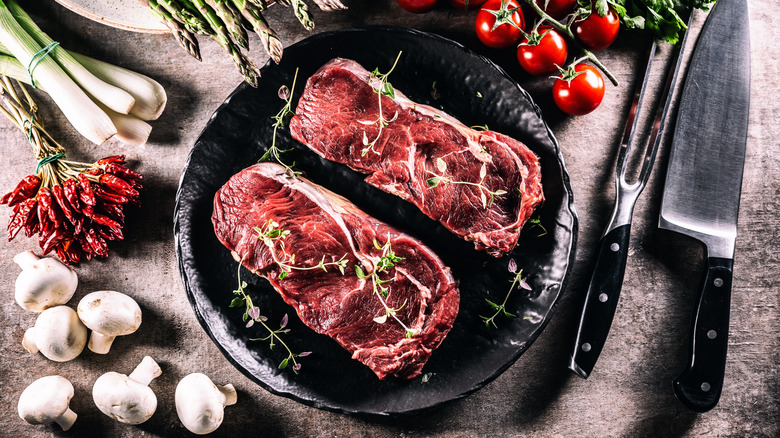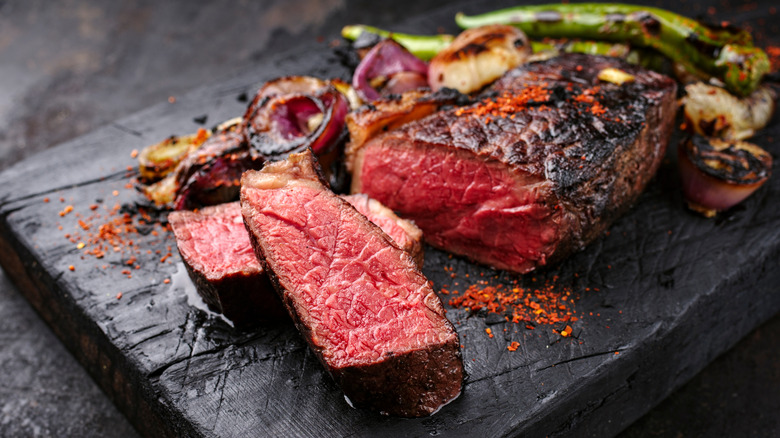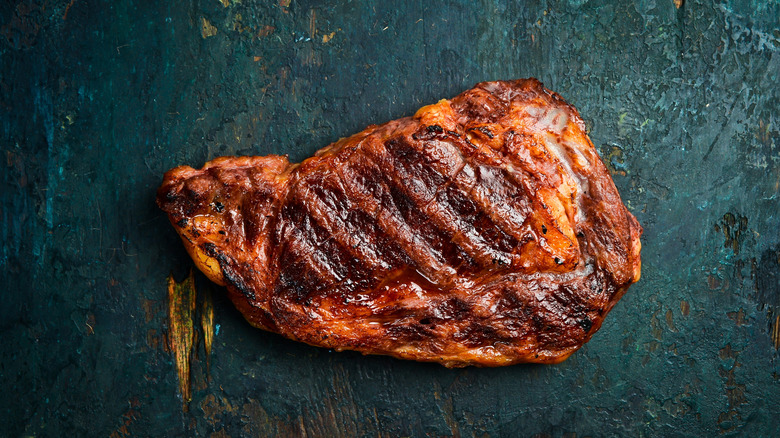Delmonico Steak Vs Ribeye: Here Are The Key Differences
For lovers of beef, there's a primal appeal to an outsized steak. And thankfully, there are a multitude of cuts to satisfy. Whether it's an eye-catching tomahawk, the distinct cowboy steak, Delmonico steak, or simply a ribeye, beef is broken down into a variety of large hunks. In fact, there are enough offerings that delineations can get tricky, so it's helpful to slice into the nuance.
Consider the ribeye vs. the Delmonico: These two beef terms can often be confusingly closely associated. In fact, they can even refer to the same style of beef. While a ribeye steak is a specific cut recognized by butchers, a Delmonico steak can refer to a variety of beef cuts — including ribeye — that are prepared in a certain way. Known for a fatty, extra-thick composition, the latter beef style gained its name by way of New York's historic Delmonico's Restaurant, alluding to a show-stopping steak.
The Delmonico steak is prepared via a high-heat method, typically broiling although sometimes grilling, developing a delicious crust and tender interior. Consequently, a ribeye perfectly satisfies such criteria, and it is often used for the dish. However, as an established cut, a ribeye can also be butchered into other forms and prepared via other methods, so keep the tricky naming conventions in mind.
Delmonico refers to a thick-cut style of steak
The Delmonico is among the most indeterminate beef styles. The meat itself can come from the rib, short loin, or even chuck part of the cow. In fact, as many as nine different cuts are assigned to the beef. And just like a ribeye, the cut can be either bone-in or boneless and comes with a fatty, typically well-marbled composition. Yet most assuredly, the steak is defined by its thickness. The Delmonico often reaches a hefty 2 inches or more, as opposed to the 1 to 1 ½-inch depth of a ribeye.
The lore surrounding such a beefy cut traces to Delmonico's Restaurant, a steakhouse that shaped American fine dining. It's said that the steak debuted as a ribeye at the restaurant in 1850, although some find the claim contentious. Yet according to the current managers, the first Delmonico steak was a ribeye, and its website calls it "our signature ribeye," so the cut is still served at locations today.
Regardless, the restaurant popularized the enjoyment of thickly-cut steaks, and it's a legacy that shines: Delmonico is all in the prepared dish rather than a particular piece of beef. The meat is classically prepared at high heat with a broiler, simple seasonings, and served alongside a compound butter for extra fat. Enjoyed alongside Delmonico potatoes (a type of casserole), it's a dining experience that transcends the type of cut used. So honor the dish's history by purchasing an extra-thick steak, and prepare it with a hot external sear.
A ribeye comes sourced from a specific part of the cow
The ribeye cut is understandably famous — its mouthwatering qualities make it one of the most in-demand steaks around. Sourced from the rib primal, this area of the cow contains an abundance of marbling and tender muscles, lending it delectable qualities. Lots of famed beef cuts, from the aforementioned cowboy cut to the prime rib, come from this area. Yet usually, the name ribeye is intertwined specifically with the ribeye steak.
This cut comes specifically from the section between the ninth and 11th ribs and contains an interior muscle encased by a fat cap. The bone can be left in or out, and either way is delicious. Perfect for a Delmonico, a ribeye shines with high heat cooking — hence why it's the perfect steak for grilling. Fatty, flavorful, and large, it shines best when served medium rare.
Such desirable qualities — combined with its small yield from a cow — have made ribeye one of the most expensive beef cuts. Prepared well, it is a dependably delicious experience, which is why it's often used for a Delmonico steak. Furthermore, the cut is regulated by the USDA — in fact, it's even used to assign grades for the entire cow. Conversely, since a Delmonico steak is a culinary term, not a butchering term, any meat can be assigned the name. So to avoid disappointment, stick to a reputed butcher — or simply buy a ribeye — to get the most out of thick cuts of beef.


